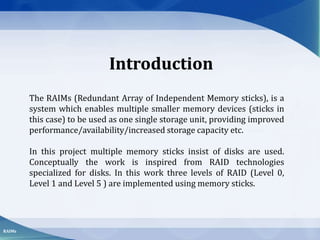RAID Technology
- 1. Redundant Arrays of Independent Memory sticks (RAIMs)
- 2. Outlines 1. Introduction 2. Features of System. 3. System Analysis. 4. System Study. 5. System Design. 6. System Implementation. 7. System Testing. 8. Problems Occurred & Their Solution. 9. Conclusion. RAIMs
- 3. The RAIMs (Redundant Array of Independent Memory sticks), is a system which enables multiple smaller memory devices (sticks in this case) to be used as one single storage unit, providing improved performance/availability/increased storage capacity etc. In this project multiple memory sticks insist of disks are used. Conceptually the work is inspired from RAID technologies specialized for disks. In this work three levels of RAID (Level 0, Level 1 and Level 5 ) are implemented using memory sticks. Introduction RAIMs
- 4. 1. Level 0 ï Provide Performance on Read/Write Operation. 2. Level 1 ï Provide Performance on Read Operation. ï Provide fault tolerance . 3. Level 5 ï Provide Error Correction mechanism (Parity) Features of System RAIMs
- 5. System Analysis RAIMs ïą Technical Feasibility ïą Economical feasibility ïą Legal Feasibility Feasibility Study
- 6. System Study RAIMs ïą RAID Technology : RAID is a method of combining several hard disk drives into one logical unit (two or more disks grouped together to appear as a single device to the host system). ïą USB Device: A USB flash drive also known as a USB stick, USB thumb drive or pen drive is a plug-and-play portable storage device.
- 7. System Design The aim of the design is to implement the system in best possible manner Design Goal ïą Correct ïą Robust ïą Flexible ïą Efficient ïą Reliability ïą Usability RAIMs
- 8. Input Part 1 Part 2 Merge all Spilt Files Output Original Final Original Final File File File Spilt Module Merge Module System Implementation Figure 1: Level 0 (Stripping) RAIMs
- 9. Input File 1 File 2 Take a file (from any one drive) Output Original Final Original Final File File File Mirror Module Retrieve Module Figure 2: Level 1 (Mirroring) ContâĶ. RAIMs
- 10. Input Part 1 Part 2 Merge File (according to select) Output Original Final Original Final File File File Split Module Merge Module Parity Figure 3: Level 2 (Parity) ContâĶ. RAIMs
- 11. System Testing Testing is a process of executing a program with the intent of finding an error ïą Technology Testing ïą Program Testing ïą Input Testing ïą Output Testing Types of Testing RAIMs
- 12. RAIMs Problem1: (Speed) File read/write was too slow. Solution: Buffer i/o stream is used instead of file i/o stream. Problem2: (Space) Java Heap space problem. Solution: Fixed buffered size. Problem Occurred & Their Solution
- 13. RAIMs ï The system runs on all existing windows operating systems. ï The system supports for all type of file type including .exe. ï The system is almost error free as we handled all exceptions that will catch every possible error. ï Deployment of system performed. Conclusion
- 14. Department of Computer Science & Engineering M.B.M. Engineering College RAIMs














